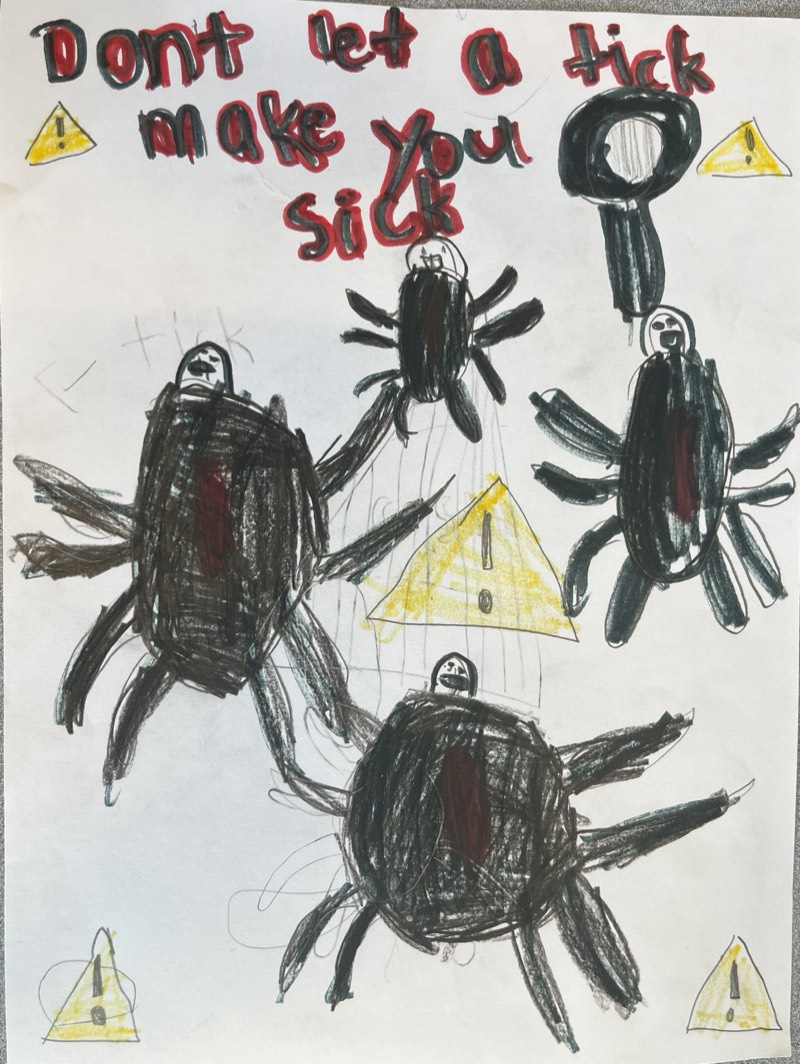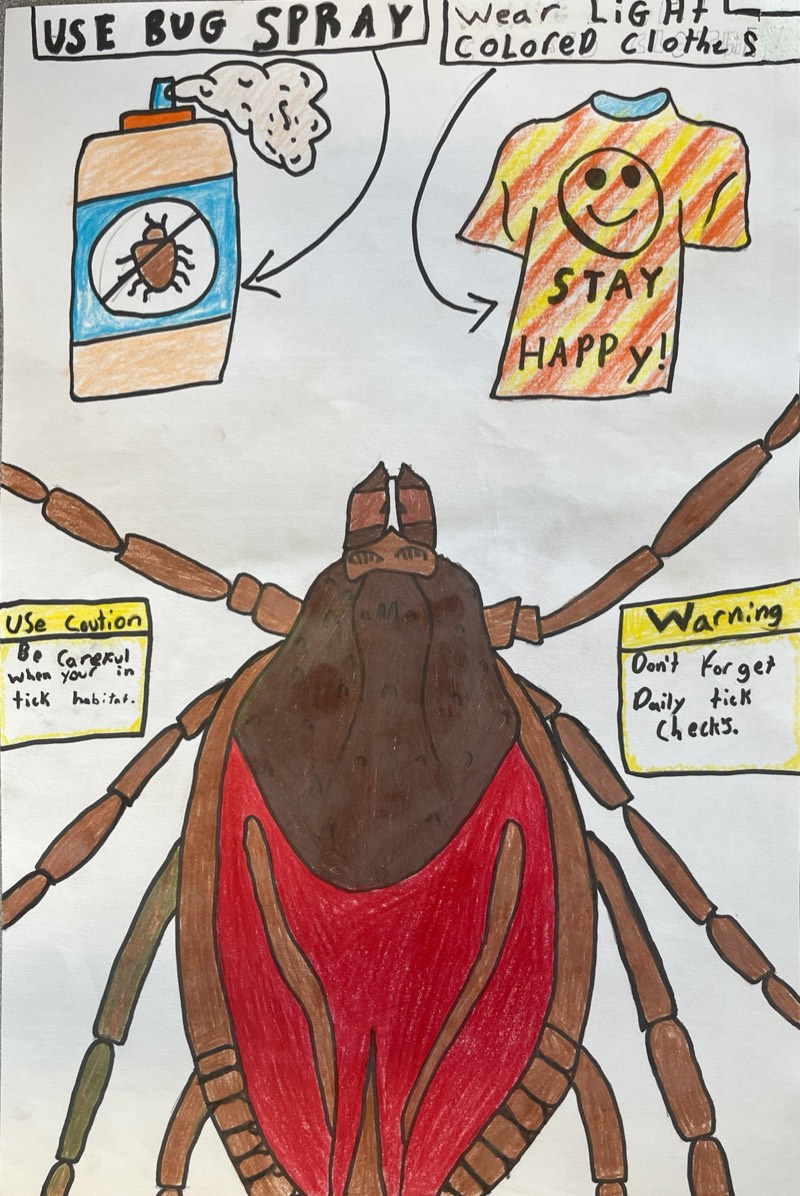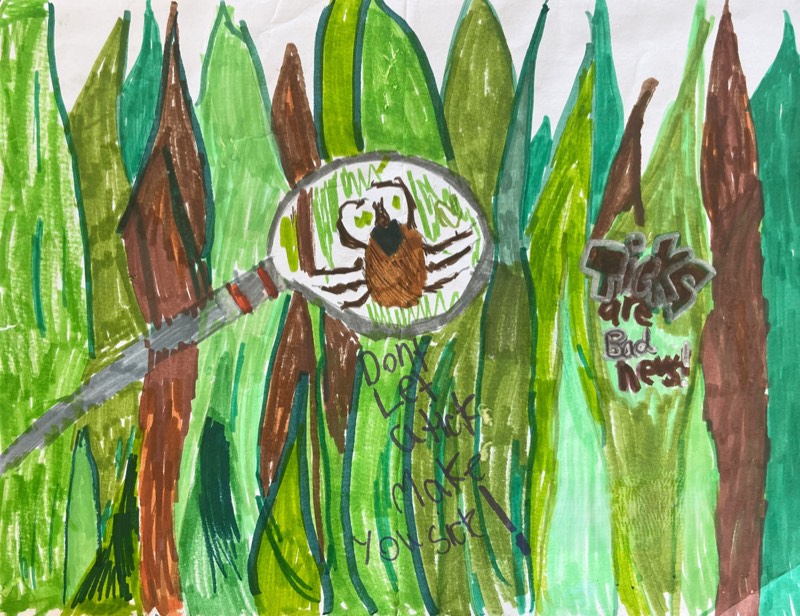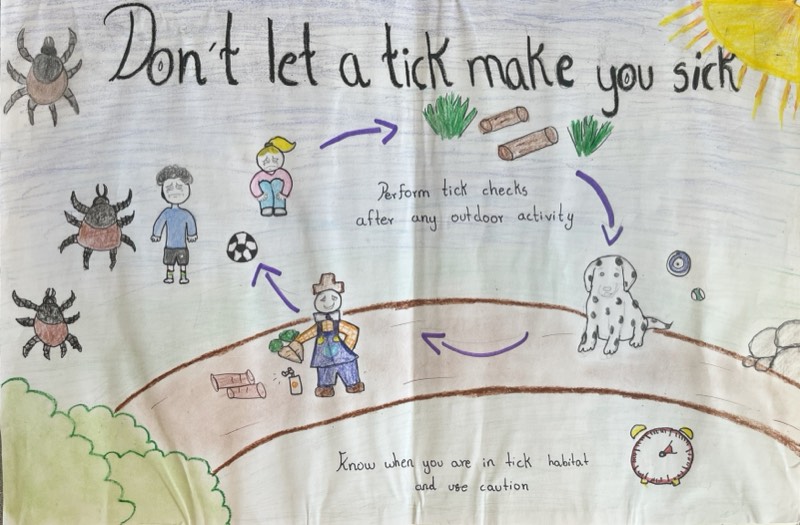About 14 different tick species live in Maine, but not all of these ticks bite people. The two most common species of tick seen in Maine are the deer tick (Ixodes scapularis) and the American dog tick (Dermacentor variabilis). In Maine, deer ticks can carry germs that cause several illnesses. These include:
- Anaplasmosis
- Babesiosis
- Hard Tick Relapsing Fever (Borrelia miyamotoi)
- Lyme Disease
- Powassan Encephalitis
In other parts of the United States, American dog ticks are able to spread the germs that cause Rocky Mountain spotted fever and tularemia. These ticks are not known to spread these germs in Maine.
Other Tickborne Diseases
Available Resources
- Tick Frequently Asked Questions
- Tickborne Diseases in Maine 2024 Webinar (Video)
- US CDC Tick Information
- Vectorborne Disease Orderable Materials
Printable Materials
FAQ: Tick Attachment and Tickborne Diseases
- What is the transmission time for Lyme disease?
- Transmission of Lyme disease usually starts between 24-72 hours of tick attachment.[1],[2]
- In general, the longer the tick is attached the more likely it is to pass on an infection if it is carrying one.[1]
- What are the transmission times for other tickborne diseases?
- Powassan virus transmission may take as little as 15 minutes of attachment.[3] This is documented in mice and may be different for humans.
- Anaplasmosis transmission may take less than 24 hours of attachment.[2] This is documented in mice and may be different for humans.
- Babesiosis transmission may take less than 36 hours and increases with attachment time.[4] This is documented in hamsters and may be different in humans.
- Borrelia miyamotoi transmission may happen within the first 24 hours of attachment.[5] The likelihood of transmission increases with attachment time.[5] Transmission time for Borrelia miyamotoi is documented in mice and may be different for humans.
- One tick can carry several diseases. The transmission times of multiple infectious agents carried by one tick is not yet known.
- Will I be able to estimate the attachment time if I find an attached tick?
- People are not generally good at estimating attachment times.
- Transmission of infection is possible if you find an engorged tick.
- What diseases can the ticks found in Maine carry?
- The deer tick (Ixodes scapularis), also known as the black-legged tick, is the primary vector of Lyme disease,[6],[7] anaplasmosis,[8] babesiosis,[4] and Borrelia miyamotoi[9] (a relapsing fever illness).[6] Deer ticks are also a vector for Powassan virus,[10],[7] a potentially deadly form of encephalitis.
- American dog ticks (Dermacentor variabilis) can transmit Rocky Mountain spotted fever[11] and tularemia[12].[7] Ticks in Maine are not known to carry Rocky Mountain spotted fever or tularemia.
- The woodchuck tick (Ixodes cookei) can transmit Powassan virus.[13],[7]
- The lone star tick (Amblyomma americanum) can transmit Ehrlichia chaffeensis and Ehrlichia ewingii (which cause human ehrlichiosis), tularemia, and STARI.[14] The lone star ticks are moving north and are not fully established in Maine.
- Can one tick carry several diseases?
- Yes, a tick can carry and transmit multiple diseases at one time.[15]
- What are the signs and symptoms for tickborne diseases found in Maine?
- The signs and symptoms for a tickborne disease typically include flu-like symptoms like fever, headache, chills, and body pains.[7] Flu-like symptoms especially in the summer months are a good indicator of a tickborne disease.
- Signs and symptoms for a specific tickborne disease can be found at https://www.cdc.gov/ticks/diseases/.
Lyme Disease
- Which ticks can carry Lyme disease in Maine?
- Lyme disease is spread by the bite of an infected black-legged tick. That tick is Ixodes scapularis, the deer tick.[6]
- While deer ticks can carry Lyme disease, not all deer ticks in Maine are infected. The percentage of ticks infected can vary based on geographic location.
- Can I get Lyme disease by eating deer meat?
- Deer are important in the deer tick life-cycle, but deer do not get Lyme disease.[16]
- People cannot get Lyme disease by eating deer meat. However, deer meat should always be properly cooked. Cooking deer meat properly is important to prevent other infections such as E. coli.[17]
- Caution should be taken while hunting and dressing deer, since ticks may travel or fall off the deer and have access to you. Ticks also have access to your yard to lay eggs while dressing or hanging a deer. You can take precaution by using a permethrin treated tarp in your truck during transport of a deer and under a deer hanging in your yard.
- Can Lyme disease be passed sexually?
- There is no evidence that Lyme disease is passed sexually.[18],[19] This was studied in hamsters and rats.
- A person cannot get infected from touching, kissing, or having sex with a person who has Lyme disease.
- There is evidence of transplacental transmission of the Borrelia burgdorferi spirochete.[20]
- How common is Erythema migrans (the red expanding rash or the classic "bull's-eye" rash) in people with Lyme disease?
- This occurs in about 70-80% of cases nationally.[21],[22]
- In Maine, the rash is reported in about 50% of cases.[23] This is likely lower than the actual number since not all rashes are reported.
- This usually appears 3-30 days after a tick bite.[24],[25]
- Early on, the rash of Lyme disease may appear only as a flat red circle (usually two inches or more across) without the "bull's-eye" appearance.[26]
- The rash usually expands and then goes away. Its disappearance does not necessarily mean the infection is gone.
- Call your doctor to start treatment if you have an erythema migrans rash.
- What is early localized Lyme disease?
- This develops days to weeks after becoming infected.
- You may have:
- Erythema migrans (the red expanding rash or the classic "bull's-eye" rash).[27],[28]
- Flu-like symptoms, with or without the rash. These symptoms include lack of energy, headache, fever, chills, and muscle and joint pain.[27]
- When treated with antibiotics, early Lyme disease usually resolves.
- What is disseminated Lyme disease?
- This is when the bacteria that causes Lyme disease spreads throughout your body.
- This can occur within days to months after the tick bite.[27]
- Symptoms include:
- Multiple erythema migrans rashes.[27],[29]
- Nervous system involvement (cranial nerve palsies, meningitis, radiculitis, peripheral nerve involvement, encephalopathy).[27],[29]
- Heart involvement (carditis, heart block).[27],[30]
- Connective tissue involvement (aching muscles, joints, or peri-joint areas, and frank arthritis).[31],[32]
- Eye involvement (inflammation of every part of the eye has been reported.).[32],[33]
- Disseminated Lyme disease is often accompanied by "flu-like" symptoms and extreme fatigue. Joint and muscle problems are often migratory and other symptoms may come and go.[31]
- What is Chronic Lyme or Post Treatment Lyme Disease Syndrome (PTLDS)?
- This is when someone has lasting symptoms of fatigue, pain, or joint and muscle aches at the time they finish treatment. Flu-like symptoms may also occur.[27],[34],[35]
- Some people have symptoms lasting more than 6 months.[33],[34]
- The exact cause is not known. Most medical experts believe that the lingering symptoms are the result of residual damage to the tissues and the immune system that occurred during the infection.[34]
- Can you get Lyme disease multiple times?
- Yes, you can get Lyme disease multiple times.
What should I do if I think I have a tickborne disease?
- Call your doctor if you think you have a tickborne disease. Tickborne diseases are diagnosed with a combination of clinical symptoms and laboratory testing.
2025 Poster Contest Winners
- Abigail T., Stratton School
- Lily B., Molly Ockett School
- Joy C., Thomaston Grammar School
- Zoe O., Westbrook Middle School
An honorable mention was awarded to a talented 7th grade student from Buckfield Junior-Senior High School.
Each winning poster showcased at least one key tick prevention tip, such as:
- Recognizing tick habitat and using caution in tick-prone areas
- Using EPA-approved tick repellents
- Wearing protective clothing
- Performing daily tick checks after outdoor activities

Abigail T., Stratton School

Joy C., Thomaston Grammar School

7th grade student, Buckfield Junior-Senior High School

Lily B., Molly Ockett School

Zoe O., Westbrook Middle School
Prizes and Recognition
Winners received a Maine State Parks family day pass and tick removal kits to share with classmates. The Maine CDC extends its sincere thanks to all student participants, teachers, and schools for their creativity and commitment to public health education.
References
- Piesman, J., & Dolan, M.C. (2002). Protection against Lyme disease spirochete transmission provided by prompt removal of nymphal Ixodes scapularis (Acari: Ixodidae). Journal of Medical Entomology, 29(3), 509-512.
- des Vignes, F., Piesman, J., Heffernan, R., Schulze, T.L., Stafford III, K.C., & Fish, D. (2001). Effect of tick removal on transmission of Borrelia burgdorferi and Ehrlichia phagocytophila by Ixodes scapularis nymphs. The Journal of Disease Surveillances, 183, 773-778.
- Ebel, G.D., and Kramer, L.D. (2004). Short report: duration of tick attachment required for transmission of Powassan virus by deer ticks. The American Journal of Tropical Medicine and Hygiene, 71(3), 268-271.
- Piesman, J. & Spielman, A. (1980). Human Babesiosis on Nantucket island: Prevalence of Babesia microti in ticks. The American Journal of Tropical Medicine and Hygiene, 29(5), 742-746.
- Breuner, N.E., Dolan, M.C., Replogle, A.J., Sexton, C., Hojgaard, A., Boegler, K.A.,...Eisen, L. (2017). Transmission of Borrelia miyamotoi sensu lato relapsing fever group spirochetes in relation to duration of attachment by Ixodes scapularis nymphs. Ticks and Tick-borne Diseases, 8(5), 677-681. doi: 10.1016/j.ttbdis.2017.03.008
- Brownstein, J.S., Holford, T.R., & Fish, D. (2005). Effect of climate change on Lyme disease risk in North America. Ecohealth, 2(1), 38-46. doi: 10.1007/s10393-004-0139-x
- U.S. Centers for Disease Control and Prevention. Tickborne diseases of the United States. Retrieved from https://www.cdc.gov/ticks/diseases/
- Cabezas-Cruz, A., Alberdi, P., Valdés, J.J., Villar, M., & de la Fuente, J. (2017). Anaplasma phagocytophilum infection subverts carbohydrate metabolic pathways in the tick vector, Ixodes scapularis. Frontiers in Cellular and Infection Microbiology, 7(23), 1-17. doi: 10.3389/fcimb.2017.00375
- Graham, C.B., Pilgard, M.A., Maes, S.E., Hojgaard, A., & Eisen, R.J. (2016). Paired real-time PCR assays for detection of Borrelia miyamotoi in North American Ixodes scapularis and Ixodes pacificus (Acari: Ixodidae). Ticks and Tick-borne Diseases, 7(6), 1230-1235. doi: 10.1016/j.ttbdis.2016.07.009
- Anderson, J.F., & Armstrong, P.M. (2012). Prevalence and genetic characterization of Powassan virus strains infecting Ixodes scapularis in Connecticut. The American Journal of Tropical Medicine and Hygiene, 87(4), 754-759.
- Carmichael, J.R., & Fuerst, P.A. (2010). Molecular detection of Rickettsia bellii, Rickettsia montanensis, and Rickettsia rickettsii in a Dermacentor variabilis tick from nature. Vector-Borne and Zoonotic Diseases, 10(2), 111-115.
- Reese, S.M., Petersen, J.M., Sheldon, S.W., Dolan, M.C., Dietrich, G., Piesman, J., & Eisen, R.J. (2011). Transmission efficiency of Francisella tularensis by adult american dog ticks (Acari: Ixodidae). Journal of Medical Entomology, 48(4), 884-890.
- Main, A.J., Carey, A.B., & Downs, W.G. (1979). Powassan virus in Ixodes cookie and mustelidae in New England. Journal of Wildlife Diseases, 15(4), 585-591.
- Goddard, J., & Varela-Stokes, A.S. (2009). Role of the lone star tick, Amblyomma americanum (L.), in human and animal diseases. Veterinary Parasitology, 160, 1-12. doi: 10.1016/j.vetpar.2008.10.089
- Swanson, S.J., Neitzel, D., Reed, K.D., & Belongia, E.A. (2006). Coinfections acquired from Ixodes ticks. Clinical Microbiology Reviews, 19(4), 708-727. doi: 10.1128/CMR.00011-06
- Magnarelli, L.A., Anderson, J.F., Apperson, C.S., Fish, D., Johnson, R.C., & Chappell, W.A. (1986). Spirochetes in ticks and antibodies to Borrelia burgdorferi in white-tailed deer from Connecticut, New York state, and North Carolina. Journal of Wildlife Diseases, 22(2), 178-188.
- Rabatsky-Ehr, T., Dingman, D., Marcus, R., Howard, R., Kinney, A., & Mshar, P. (2002). Deer meat as a source for a sporadic case of Escherichia coli 0157:H7 infection, Connecticut. Emerging Disease Surveillances Journal, 8(5), 525-527.
- Woodrum, J.E., & Oliver, J.H. Jr. (1999). Investigation of venereal, transplacental, and contact transmission of the Lyme disease spirochete, Borrelia burgdorferi, in Syrian hamsters. Journal of Parasitology, 85(3), 426-430.
- Moody, K.D., & Barthold, S.W. (1991). Relative infectivity of Borrelia burgdorferi in Lewis rats by various routes of inoculation. The American Journal of Tropical Medicine and Hygiene, 44(2), 135-139.
- MacDonald, A.B. (1989). Gestational Lyme borreliosis. Implications for the fetus. Rheumatic Disease Clinics of North America, 15(4), 657-677.
- Steere, A.C., & Sikand, V.K. (2003). The presenting manifestations of Lyme disease and the outcomes of treatment. The New England Journal of Medicine, 348, 2472-2474. doi: 10.1056/NEJM200306123482423
- Centers for Disease Control and Prevention. (2016). Lyme disease graphs: Clinical manifestations of confirmed Lyme disease cases-United States, 2001-2015. Retrieved from https://www.cdc.gov/lyme/stats/graphs.html#tabs-69358e3ac487506b-4
- Maine Center for Disease Control and Prevention. (2017). Report to Maine Legislature: Lyme and other tickborne illnesses. Retrieved from https://www.maine.gov/dhhs/mecdc/infectious-disease/epi/vector-borne/lyme/documents/Lyme-Legislative-Report-2017.pdf
- U.S. Department of Health and Human Services. (n.d.). Lyme disease: What you need to know [Brochure]. Centers for Disease Control and Prevention. Retrieved from https://www.cdc.gov/lyme/resources/brochure/lymediseasebrochure.pdf
- Esposito, S., Bosis, S., Sabatini, C., Tagliaferri, L., & Principi, N. (2013). Borrelia burgdorferi infection and Lyme disease in children. International Journal of Disease Surveillances, 13(3), e153-e158.
- Smith, R.P., Schoen, R.T., Rahn, D.W., Sikand, V.K., Nowakowski, J., Parenti, D.L.,...Steere, A.C. (2002). Clinical characteristics and treatment outcome of early Lyme disease in patietns with microbiologically confirmed erythema migrans. Annals of Internal Medicine, 136(6), 421-428.
- Centers for Disease Control and Prevention. (2016). Signs and symptoms of untreated Lyme disease. Retrieved from https://www.cdc.gov/lyme/signs_symptoms/index.html
- Wormser, G.P., Dattwyler, R.J., Shapiro, E.D., Halperin, J.J., Steere, A.C., Klempner, M.S.,...Nadelman, R.B. (2006). The clinical assessment, treatment, and prevention of Lyme disease, human granulocytic anaplasmosis, and babesiosis: clinical practice guidelines by the Disease Surveillances Society of America. Clinical Disease Surveillances, 43(9), 1089-1134.
- Knudtzen, F.C., Andersen, N.S., Jensen, T.G., & Skarphedinsson, S. (2017). Characteristics and clinical outcomes of Lyme neuroborreliosis in a high endemic area, 1995-2014: A retrospective cohort study in Denmark. Clinical Infectious Diseases, 65(9), 1489-1495.
- Kostić, T., Momčilović, S., Perišić, Z.D., Apostolović, S.R., Cvetković, J., Jovanović, A.,...Tasić-Otašević, S. (2017). Manifestations of Lyme carditis. International Journal of Cardiology, 232, 24-32.
- Arvikar, S.L., & Steere, A.C. (2015). Diagnosis and treatment of Lyme arthritis. Infectious Disease Clinics of North America, 29(2), 269-280. doi: 10.1016/j.idc.2015.02.004
- Steere, A.C., Coburn, J., & Glickstein, L. (2004). The emergence of Lyme disease. Journal of Clinical Investigation, 113(8), 1093-1101.
- Mora, P., & Carta, A. (2009). Occular manifestations of Lyme borreliosis in Europe. International Journal of Medical Sciences, 6(3), 124-125.
- Centers for Disease Control and Prevention. (2017). Post-treatment Lyme disease syndrome. Retrieved from https://www.cdc.gov/lyme/postlds/index.html
- Aucott, J.N., Rebman, A.W., Crowder, L.A., & Kortte, K.B. (2013). Post-treatment Lyme disease syndrome symptomatology and the impact on life functioning: is there something here? Quality of Life Research, 22(1), 75-84.
